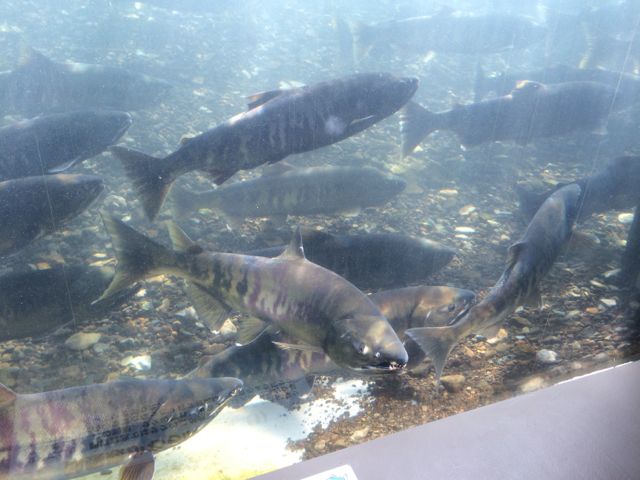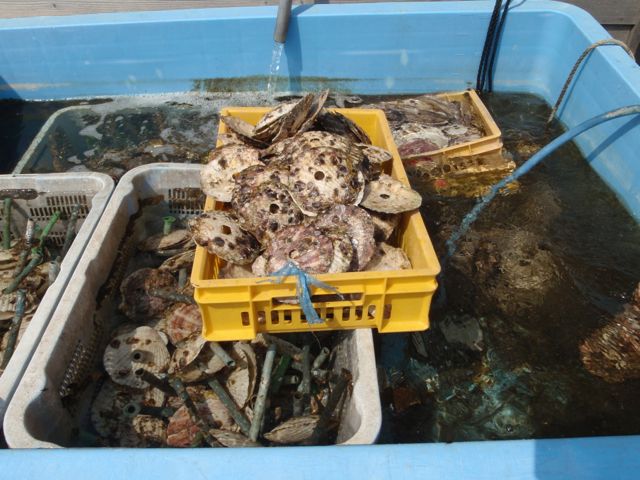13th meeting of Multispecies Anthropology in Japan
Fisheries Management and Multispecies Relations in Anthropocene
Perspectives from Environmental Humanities
| Date &Time |
December 10th 2017, Sunday 13: 00 ~ 17: 00 |
|---|---|
| Place | Meeting Room A&B, 2nd Floor, Bldg No.12 Rikkyo University Access MAP Campus MAP |
| Host: J-ARC Net Research Project "Arctic Subsistence Systems in Anthropocene" Co-host: Multispeices Anthropology Workshop (as the 13th Meeting) Language: English (No translation) |
Fisheries management is a bone of contention in recent times. Climate change is expected to bring a huge impact on the distribution of commercially important species across the globe. Local indigenous and non-indigenous groups continue to practice subsistence and/or commercial fishing in the midst of the change. While we start to have a rough global forecast for the situation of the fisheries in the era called anthropocene, we are still in need of detailed case-studies describing how local multispecies communities adapt to the changing environment. This workshop brings together the results of ethnographic studies in the U.S. and Japan to discuss how multispecies approach can shed light on the changing contexts of fishing and fisheries management in anthropocene.
Program:
13: 00 ~ 14: 00
Shiaki Kondo, Assistant Professor, Hokkaido University
Salmon and Other-than-human Engineering: Cultivating Human and Non-human Domus in Interior Alaska
14: 00 ~ 15: 00
Mariko Yoshida, Ph.D. Candidate/ Patt-time Lecturer, The Australian National University
Harvested in Suspension: Ecological Disturbances and Japanese Oyster Practices in an age of Uncertainty
15: 10 ~ 16: 30
Heather Swanson, Associate Professor, Aarhus University
The Material Politics of Fishing Gear: Lower Columbia River fish traps and the making of salmon populations
16: 40 ~ 17: 00
Discusssant
Jun Akamine, Professor, Hitotsubashi University
17: 00 ~ 18: 00
General Discussion
本研究会では、デンマーク、オーストラリア、日本の大学に所属する若手研究者3名が人新世における漁業管理と複数種の関係について文化人類学的な観点から発表した。
近藤の発表では、内陸アラスカ・クスコクィム川上流域のサケ管理を扱い、先住民が用いてきたサケ漁用の簗禁止、先住民会社と州政府によるサケ個体数の調査、サケ遡上地におけるクマ猟などの事例を通して、北方狩猟民研究と科学技術の民族誌の交差点を探る試みがおこなわれた。近藤は、先住民による「資源管理」実践と非先住民による環境破壊とが同じ複数種の絡まり合いのなかで展開されているという観察に基づき、キーストン種と人との相互構築的な関わり合いに焦点化する「マルチ・キーストン種民族誌」を提案した。
吉田氏の発表では、殖産興業を旨としてカキ養殖が導入された明治期から、海洋の酸性化や東日本大震災による海洋環境の変化といった新たな不確実性に悩まされる現代までにわたる、宮城県を中心とした日本のカキ養殖の状況が紹介された。カキ養殖は、さまざまなリスクに対応することによって形作られる。例えば、カキを媒介としたノロウィルスの流行は、食産業にとって大きな悩みの種であるが、カキ養殖業者のなかには陸上で養殖する設備を作ることによってこの問題に対処しようとする者もいる。吉田氏は、カキが新しく登場するリスクに対応しながら、さまざまな場所に移動し、その動きのなかで新しいアクターたちとの関係を築いていくさまを描き出した。
スワンソン氏の発表では、アメリカ西海岸コロンビア川におけるサケ漁具をめぐる「物質的なポリティクス」が扱われた。現地の先住民であるチヌークが作ってきた漁具とは対照的に、19世紀後半、ヨーロッパ系の入植者は、缶詰産業に供給するため、資本主義的な収奪に最適化した大規模な定置網漁法を導入した。しかし、この動きは、その数十年前から刺し網で漁をしていた北欧出身の移民たちを怒らすことになり、刺し網漁師と定置網漁業者の闘争が始まった。近年では、遺伝学にもとづいた生物多様性保全がサケ管理に導入されると、今度は漁獲するサケを選別できる定置網が環境に配慮した漁法とされ、逆に刺し網は糾弾されることとなった。スワンソン氏は、同じ特性を有する漁具でも、どのような経済的、環境的な配置のなかに置かれるかによって全く異なる姿を見せることを指摘した。
発表の後、赤嶺氏によるコメントがあった。赤嶺氏は、3本の発表に共通して、商品・社会・歴史というテーマが見られるが、市場との関係性、とりわけ商品流通を可能とする保存技術に着目する考察を加えるとよいのではないかと指摘した。研究会中の議論では、マルチスピーシーズ民族誌における「種」概念、漁具のマテリアリティ、カキのドメスティケーション、インフラストラクチャーとしての漁具、サケ漁業に関する北環太平洋をまたぐ人・技術・観念・資本の移動、more-than-humanという用語のニュアンスなど、さまざまな論点に及ぶ闊達な意見交換がおこなわれた。本研究会の参加者は合計で11名であった。(近藤祉秋)



(From Left to Right: Going Upstream of Chinook Salmon in Alaska, Swimming Upstream of Chum Salmon in Hokkaido and Releasing of Oyster Fry in Okinoshima, Photos by Shiaki KONDO)
Program:
13: 00 ~ 14: 00
Shiaki Kondo, Assistant Professor, Hokkaido University
Salmon and Other-than-human Engineering: Cultivating Human and Non-human Domus in Interior Alaska
14: 00 ~ 15: 00
Mariko Yoshida, Ph.D. Candidate/ Patt-time Lecturer, The Australian National University
Harvested in Suspension: Ecological Disturbances and Japanese Oyster Practices in an age of Uncertainty
15: 10 ~ 16: 30
Heather Swanson, Associate Professor, Aarhus University
The Material Politics of Fishing Gear: Lower Columbia River fish traps and the making of salmon populations
16: 40 ~ 17: 00
Discusssant
Jun Akamine, Professor, Hitotsubashi University
17: 00 ~ 18: 00
General Discussion
第13回研究会レポート
近藤の発表では、内陸アラスカ・クスコクィム川上流域のサケ管理を扱い、先住民が用いてきたサケ漁用の簗禁止、先住民会社と州政府によるサケ個体数の調査、サケ遡上地におけるクマ猟などの事例を通して、北方狩猟民研究と科学技術の民族誌の交差点を探る試みがおこなわれた。近藤は、先住民による「資源管理」実践と非先住民による環境破壊とが同じ複数種の絡まり合いのなかで展開されているという観察に基づき、キーストン種と人との相互構築的な関わり合いに焦点化する「マルチ・キーストン種民族誌」を提案した。
吉田氏の発表では、殖産興業を旨としてカキ養殖が導入された明治期から、海洋の酸性化や東日本大震災による海洋環境の変化といった新たな不確実性に悩まされる現代までにわたる、宮城県を中心とした日本のカキ養殖の状況が紹介された。カキ養殖は、さまざまなリスクに対応することによって形作られる。例えば、カキを媒介としたノロウィルスの流行は、食産業にとって大きな悩みの種であるが、カキ養殖業者のなかには陸上で養殖する設備を作ることによってこの問題に対処しようとする者もいる。吉田氏は、カキが新しく登場するリスクに対応しながら、さまざまな場所に移動し、その動きのなかで新しいアクターたちとの関係を築いていくさまを描き出した。
スワンソン氏の発表では、アメリカ西海岸コロンビア川におけるサケ漁具をめぐる「物質的なポリティクス」が扱われた。現地の先住民であるチヌークが作ってきた漁具とは対照的に、19世紀後半、ヨーロッパ系の入植者は、缶詰産業に供給するため、資本主義的な収奪に最適化した大規模な定置網漁法を導入した。しかし、この動きは、その数十年前から刺し網で漁をしていた北欧出身の移民たちを怒らすことになり、刺し網漁師と定置網漁業者の闘争が始まった。近年では、遺伝学にもとづいた生物多様性保全がサケ管理に導入されると、今度は漁獲するサケを選別できる定置網が環境に配慮した漁法とされ、逆に刺し網は糾弾されることとなった。スワンソン氏は、同じ特性を有する漁具でも、どのような経済的、環境的な配置のなかに置かれるかによって全く異なる姿を見せることを指摘した。
発表の後、赤嶺氏によるコメントがあった。赤嶺氏は、3本の発表に共通して、商品・社会・歴史というテーマが見られるが、市場との関係性、とりわけ商品流通を可能とする保存技術に着目する考察を加えるとよいのではないかと指摘した。研究会中の議論では、マルチスピーシーズ民族誌における「種」概念、漁具のマテリアリティ、カキのドメスティケーション、インフラストラクチャーとしての漁具、サケ漁業に関する北環太平洋をまたぐ人・技術・観念・資本の移動、more-than-humanという用語のニュアンスなど、さまざまな論点に及ぶ闊達な意見交換がおこなわれた。本研究会の参加者は合計で11名であった。(近藤祉秋)


(From Left to Right: Going Upstream of Chinook Salmon in Alaska, Swimming Upstream of Chum Salmon in Hokkaido and Releasing of Oyster Fry in Okinoshima, Photos by Shiaki KONDO)
マルチスピーシーズ人類学研究会のホームページへ